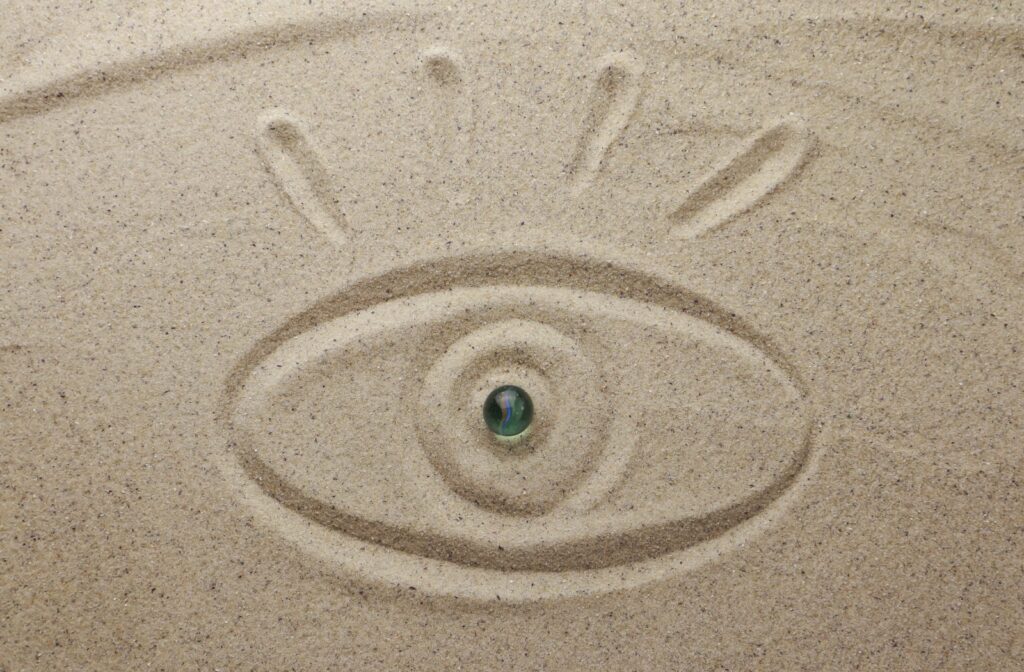Living near the coast with access to beautiful beaches has its perks; sports, picnics, sand castles. Fun in the sand is best when you can leave the sand behind, and certainly not feel it in your eyes.
The primary culprit behind a sandy sensation or irritation is often dry eye, which can worsen due to allergies, excessive screen time, or improper contact lens handling. Trying dry eye remedies can help improve symptoms.
Knowing the primary culprit behind your discomfort can help you find the relief you’re searching for. Oftentimes, a visit to your eye doctor is all it takes.
Sand in Your Eyes? Think Again
Unless you’ve buried yourself in sand at the beach, that irritating, dry, and gritty sensation in your eyes is usually not because of sand itself.
Persistent eye irritation or discomfort often stems from one or more of the following issues:
Dry Eye
Dry eye syndrome occurs when your eyes don’t produce enough tears, or the quality of those tears may not be sufficient to keep your eyes moist. This leads to dryness, irritation, and that gritty sensation.
Symptoms of dry eye syndrome include:
- Redness
- Burning or stinging sensation
- Sensitivity to light
- Blurry vision
The tricky thing about dry eye is that symptoms can worsen due to external factors, such as allergies, screen time, or living in windy or air-conditioned environments, which can strip moisture from the eyes, exacerbating dryness and irritation.
Allergies
Seasonal allergies or reactions to dust, pollen, or pet dander can cause your eyes to feel dry and gritty. Allergies often trigger inflammation and increase tear evaporation, leading to discomfort.
Extensive Screen Time
Staring at screens for extended periods without breaks reduces your blink rate, increasing the risk of digital eye strain. This lack of blinking results in a decrease in tear production, leading to a dry, gritty sensation.
Poor Contact Lens Wear
Wearing contact lenses for an extended period can aggravate ongoing dryness due to reduced oxygen flow and increased evaporation from the eye’s surface.
It’s essential to follow proper contact lens handling to reduce the risk of eye irritation and infection.
Foreign Particles
Although rare, small particles such as dust, sand, or debris can enter the eye and cause a scratching sensation. Even after removing the particle, residual irritation can persist.
If you notice sand or small debris in your eye and experience persistent discomfort, visit your eye doctor. A thorough evaluation can rule out or detect corneal scratching for timely management.

How Dry Eye Therapies Can Help
Managing the dry, sandy, gritty feeling in your eyes with targeted therapies and at-home remedies can help alleviate discomfort. More than putting a damper on your day, delaying dry eye treatment can lead to serious complications that can put your eye health and vision at risk.
Early intervention is key, and visiting your optometrist for a dry eye consultation is a great place to start. Your eye doctor can discuss your symptoms and assess the severity of your dryness to develop a personalized treatment plan tailored to your needs.
Here’s a closer look at what these treatments are:
Artificial Tears
Over-the-counter lubricating eye drops, also known as artificial tears, can quickly restore moisture to your eyes. These drops mimic the natural composition of tears, providing temporary relief to mild dryness that can stem from screen time and environmental factors.
With numerous formulas to choose from, opt for preservative-free options to minimize the risk of irritation.
Follow the 20-20-20 Rule
If extensive screen time is behind your gritty eyes, try the 20-20-20 rule. Every 20 minutes, look at something 20 feet away for 20 seconds.
This simple exercise helps encourage blinking and prevents tear evaporation while reducing digital eye strain.
Warm Compresses
A warm compress over closed eyes can stimulate the oil glands in your eyelids, improving tear quality and soothing irritation.
Simply soak a clean cloth in warm water, wring it out, and place it gently over your eyes for 5–10 minutes. Gently massage the area with your fingers to help stimulate the oil-producing glands.
Stay Hydrated
Dehydration can exacerbate dry eye symptoms. Drinking plenty of water can help maintain overall hydration, which in turn supports tear production.
Invest in a Humidifier
If you spend a lot of time in environments with dry air (like air-conditioned spaces), a humidifier can restore much-needed moisture to the air and prevent your eyes from drying out.
Consider Prescription Remedies
If over-the-counter solutions don’t help, your eye doctor may suggest alternative treatments to tackle the root cause of dry eye:
- Prescription eye drops (like Restasis or Xiidra)
- Anti-inflammatory medications
- Omega-3 supplements to improve tear quality
- Punctal plugs, tiny devices that prevent your tears from draining too quickly.
Take Control of Your Eye Comfort Today
That gritty, sand-like feeling in your eyes doesn’t have to interfere with your daily life. From simple fixes like artificial tears to treatments like punctal plugs, there are plenty of ways to find relief and restore comfort.
If you’re struggling with dry or irritated eyes, don’t wait. Schedule an appointment with Total Vision Solana Beach today! Our eye doctors are here to help you see and feel better.



